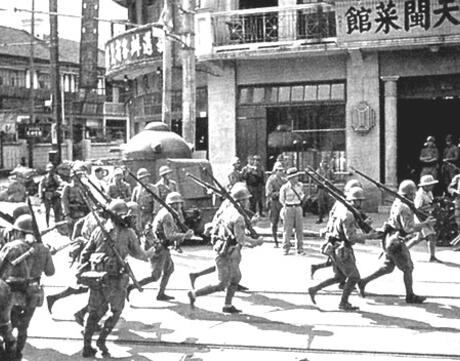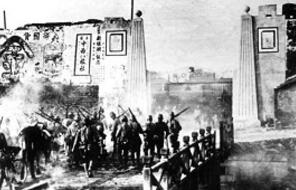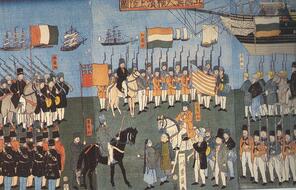In 1895, a year after the end of the first Sino-Japanese War, writer Lafcadio Hearn recounted:
The real birthday of the new Japan . . . began with the conquest of China. The war is ended; the future, though clouded, seems big with promise; and, however grim the obstacles to loftier and more enduring achievements, Japan has neither fears nor doubts. Perhaps the future danger is just in this immense self-confidence. It is not a new feeling created by victory. It is a race feeling, which repeated triumphs have served only to strengthen.
Japanese imperialism was not simply about increasing the nation’s territory. It was also fueled by a strong ideological sense of mission and racial superiority. These ideas were captured in a word widely used at the time but rarely heard today: Pan-Asianism. Advocates of Pan-Asianism in Japan believed that they were expanding their empire in order to liberate Asian territories from Western imperialism.
In the minds of many Japanese, expanding their empire into other Asian regions was somehow different from that sort of imperialism. They thought of their ambitions as bringing their Asian brethren together.
As was the case with many other imperial powers at the time, such differences were often framed in a language of racial, ethnic, and cultural superiority. Many Japanese nationalists, for instance, claimed that Japan’s rapid and successful modernization was a testament to the nation’s superiority and signaled Japan’s rightful place as the Asian leader in the region. Some believed that a necessary ingredient in furthering the expanding Japanese empire was to separate and distinguish themselves from neighboring China, despite the fact that a great deal of Japanese culture is rooted in traditions from China.
Despite the embrace of imperialist ideology in Japan, the country’s territorial expansion across East Asia unfolded gradually. Korea became a Japanese colony in 1910, and with the death of Emperor Meiji in 1912 and the ascension to power of his first son, Yoshihito, Japan’s Taisho era (1912–1926) began. In the midst of this transition, World War I broke out in Europe during the summer of 1914. Japan declared war in August 1914 and immediately sent troops to fight German forces in German colonial territories in China, including Qingdao (Tsingtao), points in Shandong, and German-held islands in the Pacific. Japan also sent naval ships to assist the Allies in the Mediterranean.
With European powers focused on the war effort, Japan in 1915 presented China with a diplomatic ultimatum known today as the Twenty-One Demands. Failing to agree to them, the Japanese threatened, would result in more war. With the political support and negotiating muscle of Great Britain and the United States, most of the demands were ultimately rejected by Chinese leaders, yet they still took a toll, further fracturing an already fragile republican government. Japan’s demands marked a new chapter in the nation’s growing militarism and expansionism. With the outbreak of World War I, Japanese manufacturing and trade experienced a tremendous boom as many domestic industries filled a large gap left by Europe’s devastated markets. As Japan’s economic prosperity grew, so did its population. In 1900, Japan’s population was 45 million. By 1925, it had reached 60 million, with the majority residing in cities rather than in the countryside.
This rapid population growth stretched Japan’s natural resources and food supplies, propelling the country’s leaders to look beyond the nation’s shores to meet domestic needs, including raw materials and space to settle for the growing populace. Ultranationalist groups within Japan’s government, military, and civilian population also advocated for the expansion of Japan’s territory to meet resource needs and to fulfill their imperial and ideological ambitions.
By the early 1920s, fearing China’s political consolidation as a possible regional rival, Japanese militarists and ultranationalists pursued an even more aggressive policy toward China. The ultranationalists and militarists demanded that Japan’s imperial forces prevent the Chinese nationalist government from controlling Manchuria, a Chinese territory where Japan held substantial commercial and political interests. By 1928, Japan’s militarist prime minister, Tanaka, sent troops to China. To him and his followers, expanding into Manchuria made sense politically, as additional territory would help ease Japan’s raw material shortage and offer a place to reside for the growing population.
With the Chinese government severely destabilized by the escalating conflict between the Chinese Communist Party and the Nationalist Party, Japanese Imperial forces capitalized on that vulnerability and successfully occupied the Manchurian city of Mukden (Shenyang) and the whole of Manchuria (in China’s northeast) by 1931. This marked the beginning of nearly a decade and a half of Japanese territorial expansion into the Asian mainland and is known by some Chinese as the start of the war of resistance to Japanese invasion that lasted from 1931 to 1945. For others, the occupation of Manchuria stands as the precursor and sets the stage for the outbreak of World War II in China.

















